Your sales team needs customer data. It’s sitting in SAP.
But instead of getting it in seconds, they’re stuck waiting on reports, digging through spreadsheets, or pinging someone in ops for the fifth time this week.
Sound familiar?
Salesforce manages the customer side. SAP handles inventory, orders, and finance. Out of the box, they don’t share a word.
That’s a problem that creates data silos, duplicate work, and gaps in the customer experience. Sales sees one version of the truth. Finance sees another. Operations is somewhere in between.
The fix? Salesforce–SAP integration.
Done right, it breaks down the walls between teams and systems, giving everyone access to the same real-time data and letting your business actually run as one.
What You’ll Learn in This Guide
- Why Salesforce–SAP integration is mission-critical in 2025.
- The most common use cases (and why they matter).
- Key challenges to watch for.
- Integration methods that actually work.
- Real tools (including no-code options) to get the job done.
Let’s make these systems talk.
Table of Contents
- Why Integrate Salesforce and SAP?
- How Salesforce SAP Integration Works: A Look Under the Hood
- Methods for Salesforce SAP Integration
- Method 1: Custom Development
- Method 2: Middleware / iPaaS (e.g., Skyvia)
- Method 3: Native Connectors
- Practical Use Cases: Bringing Salesforce SAP Integration to Life
- Conclusion
Why Integrate Salesforce and SAP?
Integrating Salesforce and SAP isn’t just a “nice to have.” It’s an entirely new step for how your business operates from the first sales call to final payment.
When these systems work together, the silos break, the data flows, and teams stop guessing and start knowing.
Let’s break down what that really means.
Achieve a True 360-Degree Customer View
Salesforce might show users that a customer booked a demo. But SAP holds the real story:
- Order history.
- Payment terms.
- Open invoices.
- Shipping status.
- Credit limits.
Without that SAP data in Salesforce, reps are flying blind.
When integrated, you get a full, real-time customer profile in one place. That means sales and support teams can have smarter conversations, catch potential blockers early, and personalize every interaction.
Supercharge Sales and Service Productivity
Manually copying SAP data into Salesforce? Toggling between tabs to check stock availability or invoice status? Total time suck.
Integration eliminates repetitive work and cuts out system-switching. Reps spend more time selling, service teams respond faster, and nobody wastes hours chasing down data that should’ve just been there.
Enhance Data Accuracy and Reliability
When data lives in silos, it gets out of sync. A customer address gets updated in SAP but not in Salesforce. One system says the invoice is paid. The other says it’s overdue.
Integration builds a single source of truth, syncing critical fields automatically and reducing human error. Everyone sees the same data, and it’s always up to date.
Streamline and Automate Key Business Processes
Think bigger than syncing fields. A proper Salesforce–SAP integration can automate entire business processes.
You can trigger the order-to-cash cycle straight from Salesforce, including quote creation, order processing in SAP, status updates flowing back automatically, invoicing, and even delivery tracking.
Less friction. More speed.
Improve Forecasting and Decision-Making
Sales forecasts based only on CRM data are half the story. Pair it with inventory levels, historical purchasing trends, and payment cycles from SAP, and suddenly your predictions start making sense.
With Salesforce and SAP working as one, your dashboards reflect reality, not just guesses, helping you plan smarter, stock better, and sell more confidently.
How Salesforce SAP Integration Works: A Look Under the Hood
At a high level, integration sounds simple: “connect the systems.”
But under the hood, there are a few moving parts that make that connection actually work reliably, securely, and without the team pulling their hair out.
LetPIs (Application Programming Interfaces) are how systems talk to each other. Think of them as digital translators that let Salesforce and SAP ask questions and exchange data in real time.
Both platforms offer robust APIs:
- Salesforce supports REST and SOAP APIs.
- SAP supports REST, OData, and traditional SOAP-based interfaces.
These APIs are what integration tools tap into, pulling data from one system and pushing it to the other. Without them, you’d be stuck with manual exports, CSV files, and a lot of frustration.
Key Integration Patterns: Real-Time vs. Batch
Not all data needs to move instantly. Some need to be lightning-fast; some just need to show up eventually. That’s where integration patterns come in.
Data Replication / Synchronization (Batch)
This pattern copies data between Salesforce and SAP at set intervals (hourly, daily, or however users configure it). It’s perfect for data that changes regularly but doesn’t need to update in real time.
Use cases:
- Product catalogs.
- Customer master data.
- Order history.
This is often handled via scheduled jobs or workflows in an integration platform.
Real-Time Access (Live Integration)
Instead of copying the data, this approach accesses it on-demand, pulling SAP data into Salesforce (or vice versa) when it’s needed, without actually storing it in both places.
Use cases:
- Live inventory checks during quoting.
- Real-time price calculations.
- Viewing open invoices or delivery status in Salesforce.
This method is more complex but critical for high-speed operations like finances and banking, etc., where timing matters.
Note: You may use these integration patterns separately or together, depending on the use case. Some businesses replicate basic info in batches but use real-time access for anything customer-facing or revenue-impacting.
Methods for Salesforce SAP Integration
There are a few main ways to connect Salesforce and SAP, and each comes with trade-offs. Users’ choices depend on their teams’ technical skills, integration goals, and the balance between flexibility and simplicity they need.
We’ll break down the three main approaches:
But first, here’s a quick side-by-side comparison:
| Method | Pros | Cons | Best For | Example Tools |
|---|---|---|---|---|
| Custom Development | Fully tailored, total control. | Time-consuming, code-heavy, high maintenance. | Enterprises with dev resources, edge cases. | Custom APIs, SAP PI/PO, Apex code. |
| Middleware / iPaaS | Scalable, flexible, low-code or no-code. | May require initial configuration, platform learning. | Mid-to-large teams, long-term automation. | Skyvia, MuleSoft, Boomi, Jitterbit. |
| Native Connectors | Fast setup, user-friendly. | Limited flexibility, often app-specific. | Simple use cases, lightweight sync. | SAP BTP, Salesforce AppExchange apps. |
Method 1: Custom Development
This approach is about building a direct, point-to-point integration between Salesforce and SAP using custom code or proprietary connectors, typically via REST, SOAP, OData, or SAP BAPIs.
Best for
- Organizations that need full control.
- Complex edge cases (e.g., custom BAPI workflows).
- Teams with deep Salesforce and SAP dev expertise.
Step‑by‑Step Guide
- Define the integration scope. Identify which SAP data (invoices, orders, inventory) needs to flow into Salesforce: document fields, data types, and any transformation rules.
- Connect to SAP APIs. Use SAP JCo (Java Connector), .NET Connector, or OData endpoints to authenticate and retrieve data (usually via BAPIs or OData services.
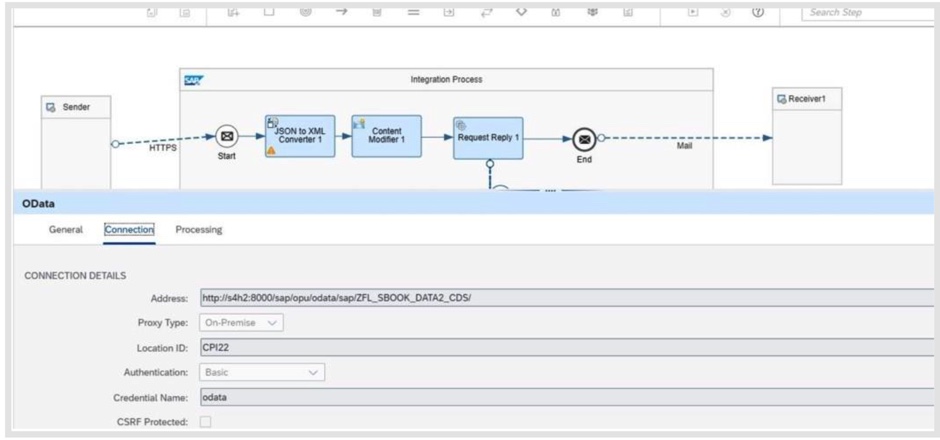
3. Set up Salesforce callouts. In Salesforce Apex code, configure outbound callouts to SAP APIs.
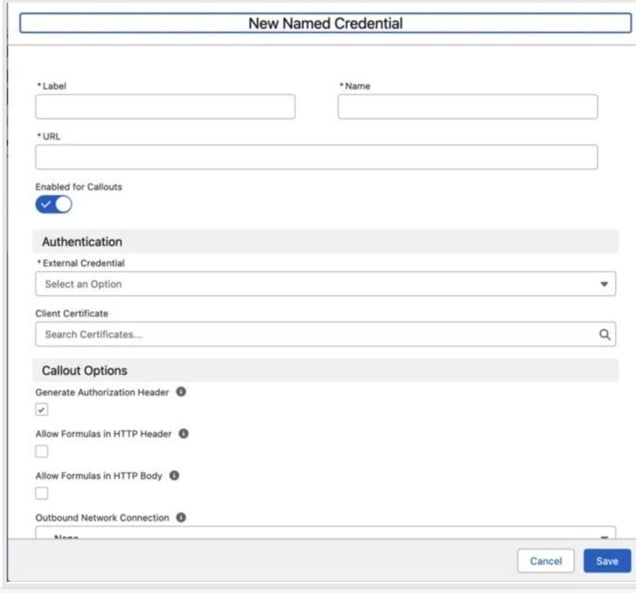
- Transform and map data. Write transformation logic in code to normalize formats, handle missing values, and map nested structures. Maintain mapping tables or dictionaries if needed.
- Schedule data flows. Use cron-style schedulers or Salesforce Scheduled Apex/Bulking logic to sync data at needed intervals. Implement pagination and batching to avoid timeouts.
- Error handling and logging. Build in retry logic for failures and log errors to custom objects or external monitoring systems.
- Test in sandbox. Use dev and UAT environments to validate data, catch mapping mistakes, and tune performance before going live.
- Deploy and maintain. Roll out to production with change sets or CI/CD. Maintain version control and document every mapping and business rule.
Method 2: Middleware / iPaaS (e.g., Skyvia)
Using a third-party platform as a central hub means no custom code, just a clean setup and automation.
Best for
- Mid to large businesses wanting automated, reliable integration.
- Teams that prioritize scalability, monitoring, and reusability.
- Non-developers or hybrid teams needing flexibility without code.Step‑by‑Step Guide
For this walkthrough, we’ll use Skyvia, a no-code iPaaS platform, as the example. Why? Because it offers a clean UI, prebuilt connectors for both Salesforce and SAP (plus hundreds more), and a visual data flow designer that doesn’t require writing a single line of code.
This is what the process looks like:
- Connect Your Accounts. Create secure, no-code connections to both Salesforce and your SAP environment (or SAP-connected database). To do it: Go to the Connections tab in Skyvia and select + Create New.
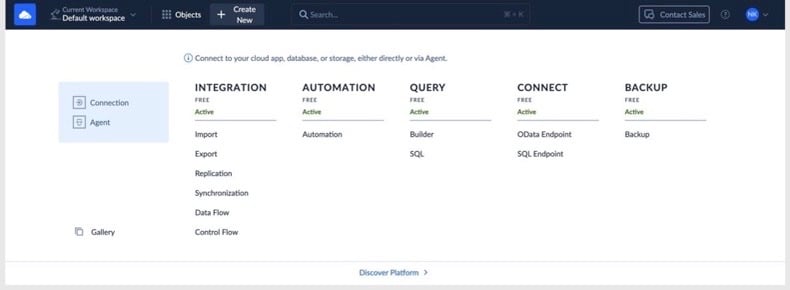
- Choose the appropriate connectors.
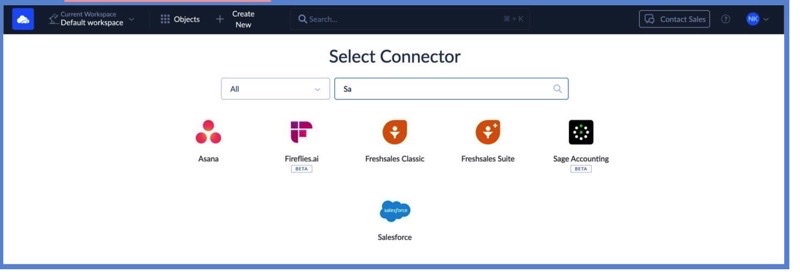
- Create a data flow. Open Skyvia’s Data Flow editor and drag in your source (Salesforce) and destination (SAP or SAP DB).
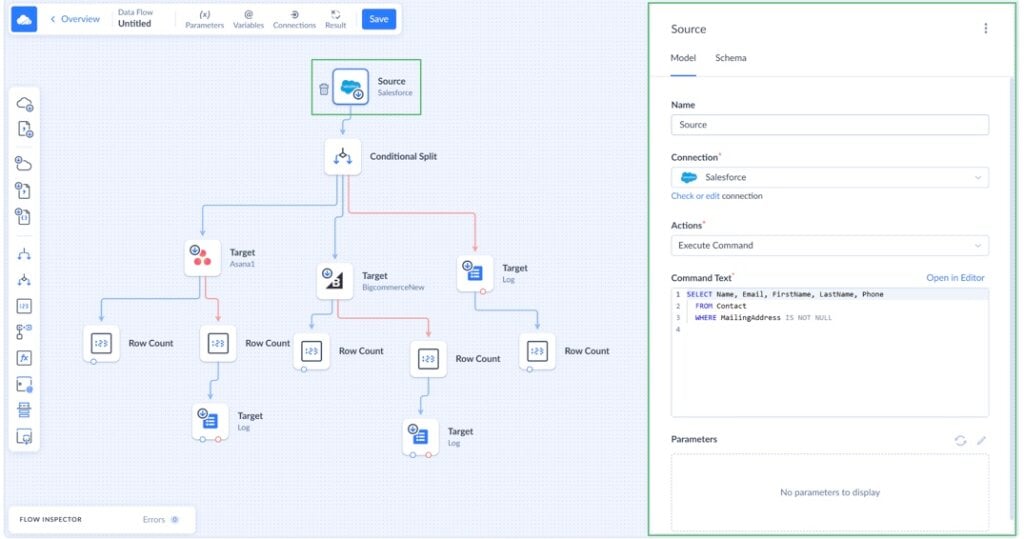
- Map and Transform Fields. Use Skyvia’s mapping interface to align fields and transform data. Reformat dates, apply lookups, or insert default values.
- Schedule or Trigger the Flow. Choose how and when the integration runs: hourly, daily, or based on specific conditions.
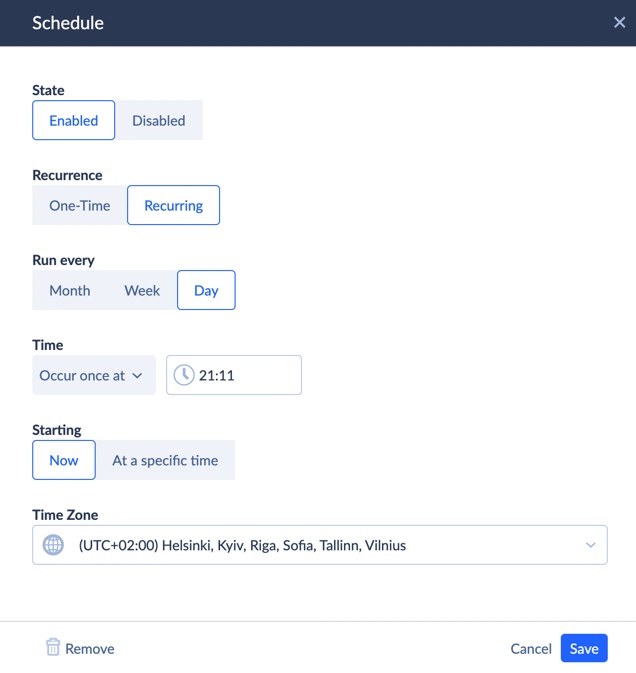
- Monitor Runs and Logs. Track every integration run with Skyvia’s built-in logs. Get alerts, view success/failure counts, and debug with detailed row-level info.
Pros
- No code required; drag, drop, and configure.
- Scalable, cloud-native execution.
- Built-in monitoring and error logging.
- Supports 200+ connectors, like Salesforce, SAP, databases, and apps.
- Easy to update and transfer ownership.
Cons
- The platform offers a free version, but for more complex tasks, use plan with the more functionality.
- Some complex use cases may still require custom scripts or extended logic.
Method 3: Native Connectors
Use SAP Integration Suite (on SAP BTP) to connect Salesforce and SAP without custom code, with SAP’s own integration platform for robust, vendor-backed workflows.
Best for
- Teams with standard SAP and Salesforce modules.
- Businesses seeking supported templates and minimal custom logic.
- Projects aligned with SAP ecosystems and enterprise-grade SLAs.
Step‑by‑Step Guide
- Select Integration Suite in BTP Cockpit. Navigate to SAP BTP subaccount → enable the Integration Suite service.
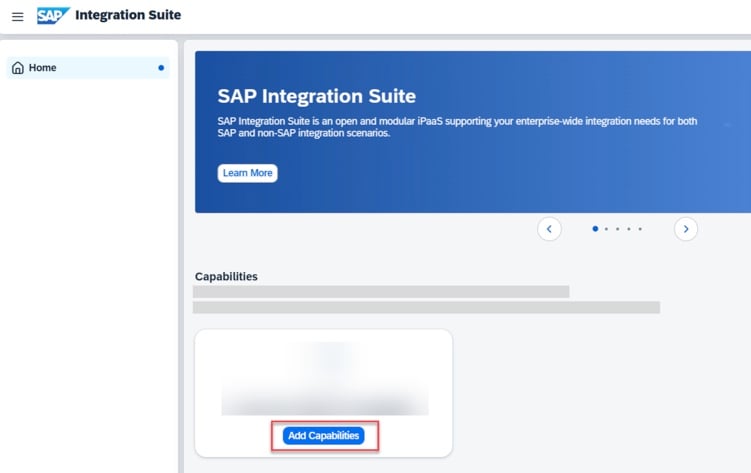
- In your BTP subaccount, go to Instances and Subscriptions and select Integration Suite, then click Go to Application. Accept the terms and complete the setup if prompted after it.
- Use the Integration Flow Designer. In the Design view, create a new iFlow to connect systems (e.g., Salesforce to SAP).
- Add Sender Adapter (Start → HTTPS Sender). Drag in the HTTPS or REST sender adapter and configure its endpoint, authentication, and message type.
- Add Processing Logic. Insert a Message Mapping, Content Modifier, or Groovy script to transform incoming data before sending it to the receiver.
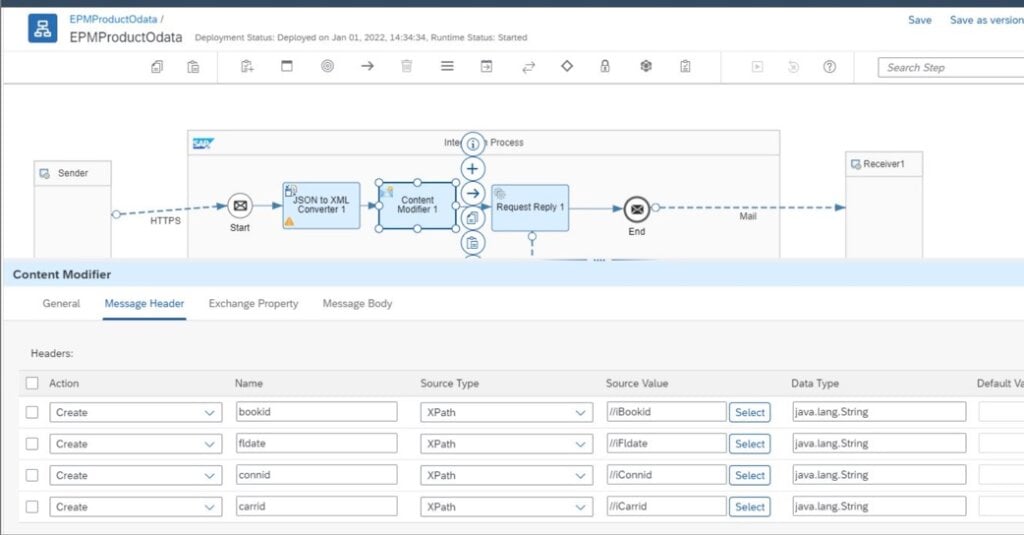
- Add Request‑Reply and Receiver Adapter. Use a Request‑Reply step to call an external service (e.g., Open Connectors), then configure your Receiver adapter (OData, SOAP, RFC) for the destination system.
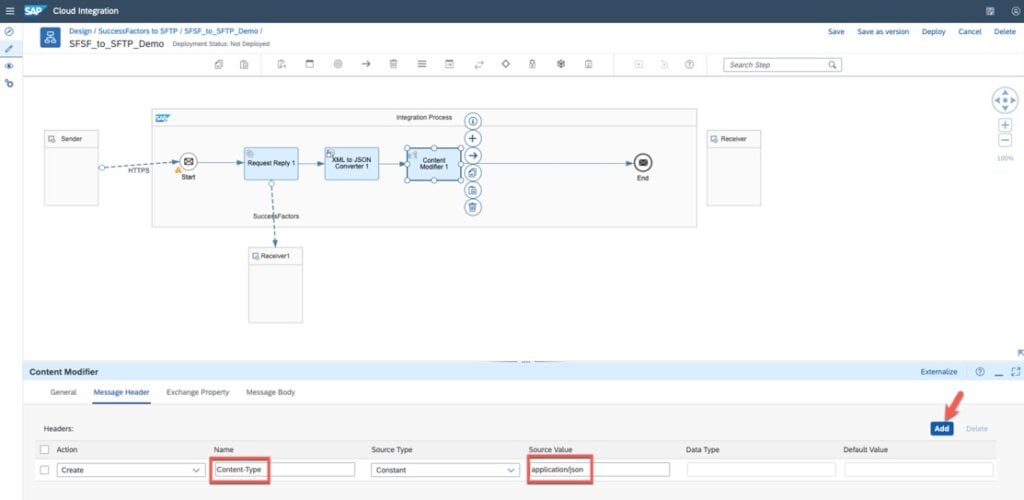
- Finalize, Deploy, and Monitor. Connect all steps: Start → Mapping → Receiver → End → then click Deploy → Go to Monitor → Manage Integration Content to verify and test.
Pros
- Handles authentication (OAuth2) securely, with no manual token handling.
- Built-in API abstraction makes working with Salesforce data easier.
- Scalable, cloud-native execution within SAP BTP.
- Prebuilt connectors reduce development and integration time.
- Supports filtering, pagination, and common Salesforce actions out of the box.
- Easy to update flows or transfer ownership between teams.
Cons
- There is a free version, but for more advanced usage, a paid license is required.
- Not all Salesforce features are available. Limited to what’s exposed via the connector.
- Some complex use cases may still require scripting (e.g., Groovy for transformations).
- Slight latency overhead due to routing through Open Connectors.
- Custom error handling and retries can be less flexible than direct API calls.
- Dependency on SAP’s support and roadmap for connector updates or fixes.
Practical Use Cases: Bringing Salesforce SAP Integration to Life
You’ve set up the connection, and the flows are in place. Now what?
This is where the magic happens.
Let’s talk real use cases. Actual day-to-day wins. The kind of stuff that makes your team go, “Wait, Salesforce is doing that now?”
Sales
Real-time inventory lookup from Salesforce
The sales rep is on a call, looking at a deal in Salesforce. “Do we have 500 units in stock?” Instead of emailing someone in logistics, they click. Boom. SAP inventory data, real-time, right there in Salesforce.
Example: Redmond Inc. synced inventory and order data from Shopify to their ERP system using Skyvia, powering real-time service dashboards and saving $60K per year.
Automated quote and order creation in SAP
Opportunity hits “Closed-Won”? Salesforce kicks off an iFlow. SAP creates the order automatically.
- No manual entry.
- No copy-paste errors.
- Just one smooth handoff from front office to back office.
Example: Echo Technology Solutions used Skyvia to automate Salesforce pipelines, streamlining quote-to-order processes with zero developer effort.
Customer Service
Order and shipping info, right in Service Cloud
A customer calls: “Where’s my stuff?”
Your support agent sees the full SAP order history and delivery status inside the Salesforce Service Console.
No Alt+Tab, no waiting. Just answers.
Example: Cirrus Insight automated data sync between Salesforce and tools like QuickBooks and SQL Server, giving reps instant access to cross-platform order histories.
Finance
Sync customer master data
New customer account in Salesforce? It syncs to SAP automatically: names, addresses, and tax IDs. No need for double entry or “just email me the details.”
Example: ERP Automation Platform used Skyvia to keep Salesforce and their ERP platform in sync via BigQuery, ensuring customer records stayed clean, complete, and consistent.
Auto-generate invoices from Salesforce deals
Once the deal’s closed, Salesforce pushes the billing data to SAP. It generates the invoice. Finance doesn’t need to chase anyone.
Example: A4 International, Inc. replicated engineering and quoting data from legacy systems into Salesforce in real time, enabling fast, accurate billing right off the opportunity record.
Best Practices for a Successful Salesforce SAP Integration Project
So you’ve decided to integrate Salesforce with SAP. Great. Now, ensure it actually works.
Let’s consider the things people wish they’d done the first time.
Start with a Clear Strategy
Before you touch a single flow, get aligned.
- What are you trying to achieve?
- Which systems own what data?
- How will you know if it’s working?
Define goals, data scope, and success metrics early, not after you’ve built a monster.
Involve Cross-Functional Teams
This isn’t just IT’s project. It affects everyone, so bring everyone in.
- Sales knows the CRM pain points.
- Finance knows where the invoice data breaks.
- IT knows what’s actually possible.
- SAP experts know what really happens under the hood.
The earlier they talk, the fewer “wait, what?” moments you’ll have later.
Prioritize Data Governance and Security
It’s easy to forget this until something breaks. Don’t.
- Ensure the fields match between systems (mapping is everything).
- Define who owns what and who can change it.
- Encrypt sensitive data, control access, and monitor it regularly.
If your data isn’t clean, your integration will just spread the mess faster.
Plan for a Phased Rollout
Don’t go live with everything all at once.
- Start with a pilot use case (e.g., closed-won opportunities triggering SAP orders).
- See how it behaves, what breaks, and what needs tweaking. Then scale up.
- Iterate. Adjust. Then roll out to the rest of the business.
Don’t Underestimate the Need for SAP Expertise
Salesforce is flexible. SAP… is SAP.
Understanding how SAP handles master data, transactions, and business rules is foundational.
You don’t need an army of ABAP developers, but you do need someone who can explain why that one field you thought didn’t matter just broke an entire process chain.
Conclusion
Integrating Salesforce and SAP is no longer a luxury.
Connected systems are how modern businesses stay fast, accurate, and competitive, especially when you’re trying to:
- Streamline sales operations.
- Sync customer data.
- Automate invoicing.
There are different ways to approach integration, like custom APIs, middleware platforms, and native tools. But for most organizations, an iPaaS (Integration Platform as a Service) delivers the right mix of power, flexibility, and cost-effectiveness.
That’s where Skyvia is a good choice.
It’s a no-code iPaaS that simplifies complex data integrations without compromising on features. The platform suits teams that need reliable, scalable connections without writing custom code or managing fragile scripts.
With Skyvia, you get:
- Prebuilt connectors for Salesforce, SAP (via database or staging), and other systems.
- A visual workflow builder that’s intuitive for non-developers.
- Robust error handling, logging, and monitoring.
- Support for data replication, scheduled syncs, and transformation logic.
- Quick setup and low ongoing maintenance, perfect for lean teams.
Ready to make Salesforce–SAP integration simple, reliable, and scalable?
Get started with Skyvia today.
F.A.Q. for Salesforce SAP integration
Can I integrate Salesforce and SAP in real-time?
Yes. With the right setup, you can enable real-time or near real-time syncs using iPaaS platforms like Skyvia, Jitterbit, Workato, Informatica Cloud, or SAP Integration Suite.
What are some common use cases for Salesforce SAP integration?
Order creation, customer data sync, inventory lookups, invoice automation, and delivery tracking, all directly from Salesforce.
Is it difficult to integrate Salesforce and SAP?
Not with the right tools. Platforms like Skyvia, MuleSoft, and Boomi offer no-code or low-code options that simplify setup, reduce errors, and avoid costly custom dev work.



